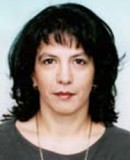

Plenary Lecture
The Second Order Characteristics Analysis by Using the Probability Density Functions of Signals and Derivatives in Two Time Instants for SSC Combiner in Fading Channels

Dr. Dragana Krstic
Department of Telecommunications
Faculty of Electronic Engineering
University of Nis
SERBIA
E-mail: dragana.krstic@elfak.ni.ac.rs
Abstract: Fading is one of the most important causes of degradation signals in wireless communication systems. Ricean fading is a stochastic model for radio propagation anomaly caused by partial cancellation of a radio signal - the signal arrives at the receiver by several different paths, and at least one of the paths is changing - lengthening or shortening. Rician fading occurs when one of the paths, typically a line of sight signal, is much stronger than the others.
Rayleigh fading is the specialised model for stochastic fading when there is no line of sight signal, and is sometimes considered as a special case of the more generalised concept of Rician fading. In Rayleigh fading, the amplitude gain is characterized by a Rayleigh distribution. Nakagami-m distribution describes multipath scattering with relatively large delay-time spreads, with different clusters of reflected waves are described. In that way good fits to collected data in indoor and outdoor mobile-radio environments are provided. Slow fading can be caused by events such as shadowing, where a large obstruction such as a hill or large building obscures the main signal path between the transmitter and the receiver. The amplitude change caused by shadowing is often modeled using a log-normal distribution with a standard deviation according to the log-distance path loss model.
In telecommunications, a diversity scheme refers to a method for improving the reliability of a message signal by using two or more communication channels with different characteristics. The diversity plays an important role in combatting fading effect and co-channel interference and avoiding errors. It is based on the fact that individual channels experience different levels of fading and interference. Multiple versions of the same signal may be transmitted or received and combined in the receiver.
When space diversity is used the signal is transmitted over several different propagation paths. In the case of wireless transmission, it can be achieved by antenna diversity using multiple transmitter antennas (transmit diversity) and/or multiple receiving antennas (reception diversity). In the latter case, a diversity combining technique is applied before further signal processing takes place. Various diversity combining techniques can be distinguished. At Selection Combining (SC), from N received signals, the strongest signal is selected. At Switched Combining the receiver switches to another signal when the currently selected signal drops below a predefined threshold. This is a less efficient technique than selection combining, but less expensive, too. The expressions for probability density functions (PDFs) of the signal time derivatives at two time instants for output signals from dual branch SSC combiner in the presence of different fading distribution (Rayleigh, Rician, Nakagami-m, log-normal) are derived. The second order characteristics such as the average level crossing rate and the average fade duration for complex combiner who makes the decision based on sampling in two time instants are calculated by using the obtained closed-form expressions. It is shown that performances are improved in this case.
Brief Biography of the Speaker: Dragana S. Krstic was born in Pirot, Serbia. She received the BSc, MSc and PhD degrees in electrical engineering from Department of Telecommunications, Faculty of Electronic Engineering, University of Nis, Serbia, in 1990, 1998 and 2006, respectively. Her field of interest includes telecommunications theory, optical communication systems, wireless communication systems, satellite communication systems etc. She works at the Faculty of Electronic Engineering in Nis since 1990. She participated in more Projects which are supported by Serbian Ministry of Science. She has written or co-authored about 150 papers, published in Journals and at the International/National Conferences. She has also reviewed more articles in IEEE Transactions on Communications; IEEE Communications Letters; ETRI journal; C&EE Journal; Electronics and Electrical Engineering (Elektronika ir Elektrotechnika) and other journals. She is the reviewer of the papers for many conferences and the member of technical program committees and international scientific committees of several scientific conferences.